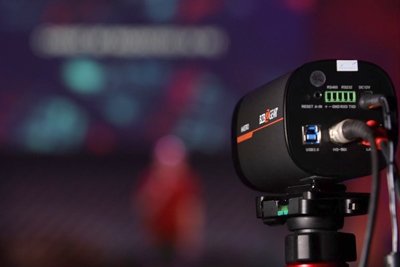Recently, I have been reminded how hard it is to find enough tech volunteers weekly, especially over the summer months. With the kids out of school and vacations on the calendar, the balmy summer months are tough for tech teams all over the country. This is a scenario where the BZBGEAR BG-Maestro auto-tracking ePTZ camera could be a massive asset to a church.
BZBGEAR has taken an interesting approach to auto-tracking; the Maestro auto-tracks by taking advantage of an oversampled 4K image and cropping it for a 1080p output. All that extra resolution allows the camera to pan the output raster around the image. While this camera seems purpose-built for educational spaces and conference rooms, there is a solid argument that it will perform well in houses of worship.
One of the things that surprised us right away was the image quality. The image was clear and far less noisy than expected.
Tech specs
The I/O on the Maestro is relatively simple: one USB 3.0 port, one LAN port, one 3.5mm port, a 12V DC power port, some Phoenix connectors for RS 485 and RS 232, and finally, an HDMI or SDI connector (depending on model). Each of these connectors is straightforward, HDMI or SDI for signal, LAN connection allows for browser-based GUI control and streaming directly to sites like Facebook and YouTube. The USB 3.0 connection provides for integration with applications like vMix, Wirecast, and Zoom. The 3.5mm port allows for audio injection, particularly useful if the BG-Maestro is streaming directly to the web.
In use
One of the things that surprised me right away was the image quality. Based on the lens size, I was prepared for the BG-Maestro to look like my built-in laptop camera, and so I made a side-by-side comparison. As it turns out, the BG-Maestro was the clear winner by a long shot. The image was clear and far less noisy than expected for such a small lens, probably because behind that lens is a 1/2.8-inch high-quality 4K CMOS sensor. Once configured, the auto-tracking works excellent left to right. However, it has no appreciation for headroom and Z space. So, if you configure it for someone really short, hypothetically like my 14-year-old son, it may crop the head of someone like me, who's of average size. In this hypothetical example, the auto-track might solidly lock on my body enough to remind me I’m not beach weather-ready. Thanks, BZBGEAR.
Also, if your subject moves forward or backward on the stage, the Maestro maintains the configured area with no regard for adjusting the headroom, at least not in my tests. So, if the speaker moves forward, they may get the top of their head cropped, and if they move backward, they just look like they are falling out of frame. The lead tech at BZBGEAR concurs, saying, “It doesn't auto zoom in or out or tilt up and down. It should be configured for one person walking back and forth at the same distance away from the camera." However, the left/right tracking was good. If your speaking pastor is a runner, it might lose them for just a moment. On balance, the tracking wasn’t any worse than many manned camera operators I have seen, and I would even go as far as to say better than some—not any of my volunteers, mind you.
GUI
Setting the camera up is not difficult, and the instruction manual is only 30 pages long, with many of those pages being half blank. I could get it set up and functioning in about five minutes. Setting up the auto-tracking may take another five to 10 minutes. The user interface is easy to understand and navigate, and although setting up the auto-tracking is a process, it's not a difficult one.
BZBGEAR has a walk-through on its website that takes you step-by-step through the process, and that video is only 13 minutes long. So, while it wasn’t plug-and-play, it was pretty close. There are many options in the GUI for the auto-tracking that are more specific to classroom applications, so it will be interesting to see how those features could be used to improve the Maestro for houses of worship.
With the price point at $999, I think it’s a good value, and I will be keeping an eye on BZBGEAR moving forward.
ConclusionSo, the big question: “Is it there?” It’s tough because I’m not 100% comfortable saying, “Yes, it’s there. If you are looking for an auto-tracking camera, go buy it now!” At the same time, it’s very close. Would I want to use this in prime time on national TV? No. Would I be ok with a small church replacing an outdated unmanned fixed camera with this? Absolutely. If your church is only going to have one camera and does not have the support staff or volunteers to cover the care and feeding of your tech, this is a product you should consider.
However, what is really exciting, I believe, is that this technology is a few firmware updates from being ready for prime time; it’s that close. The hard part is done. I think it’s simply a matter of BZBGEAR perfecting what they have, and I am a huge fan of what this camera represents. I also think that, even today, this product would help most churches deliver a noticeable upgrade over what they currently produce. And with the price point at $999, I also think it’s a good value. So, I will be keeping an eye on BZBGEAR moving forward.





